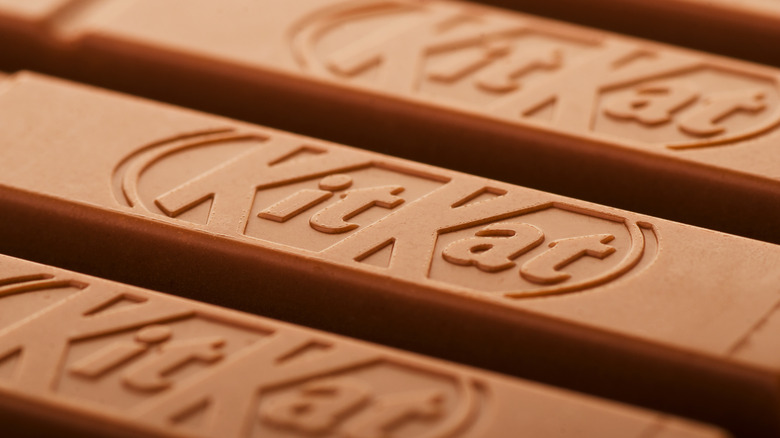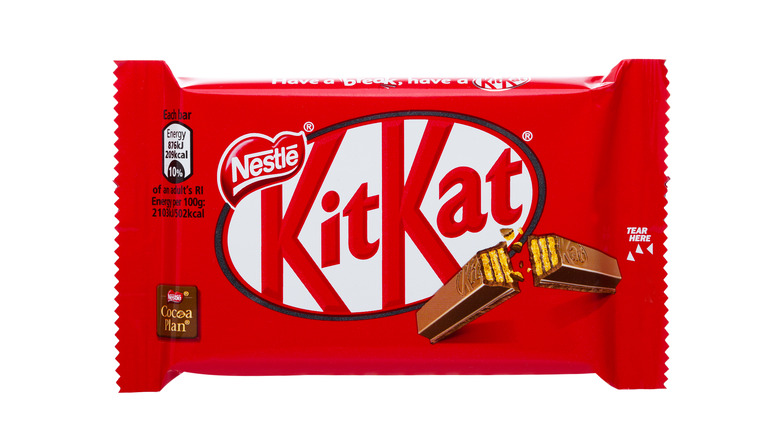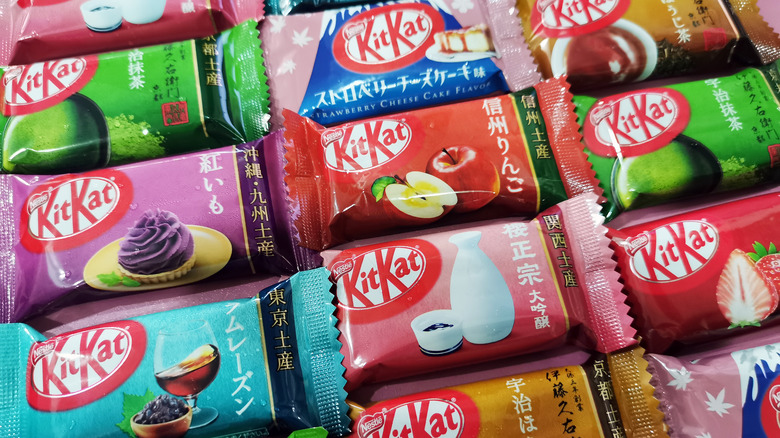Why Kit Kat Is Both A Hershey And Nestlé Bar
When you crave something sweet, it's not uncommon to reach for a trusty Kit Kat. Yes, this beloved bar of chocolate that longs to "give you a break" is a fan favorite with its wafer layers smothered in milk chocolate. It's hard to imagine a world without Kit Kat.
After all, it's a hugely popular confection. When YouGov asked 1,000 children to share their favorite candy, the Kit Kat bar earned a respectable fourth-place finish. Data from Statista echoes America's penchant for the Kit Kats stating that in 2020, more than 11 million people devoured at least five servings. Clearly, this is a nation of Kit Kat-eaters.
Americans aren't the only ones who love this milk chocolate quartet. If you take solace in spotting the golden arches, the Colonel's chicken bucket, or other familiar foods when you travel abroad, you will be happy to know that the Kit Kat has made its way to many corners of the planet. There is, however, one important caveat. The candy bar that lives in London, Tokyo, Istanbul, or even Toronto won't be the same as the one at your local convenience store. After all, your American-born bar was created by Hershey. Everywhere else, it's not.
Hershey and Nestlé Kit Kats taste quite different
In fact, the Kit Kat isn't an American creation at all but hails from across the pond in Britain. As Mental Floss contends, it was born in 1935 and originally bore the name Rowntree's Chocolate Crisp. By 1937, its moniker had changed to Kit Kat Chocolate Crisp and was soon shortened to Kit Kat. The New York Times adds that in 1988 Nestlé purchased the British company, acquiring Rowntree's brands. So how did the Hershey Company come to manufacture the Kit Kat in America?
Snack History explains that Rowntree had a distribution deal with Hershey's, allowing the company to produce and sell the Kit Kat bar in the United States. When the company was sold to Nestlé, Hershey's maintained this position. Apparently, the original contract said that the only thing that could halt this arrangement would be if Hershey's was bought out by another company. Furthermore, manufacturing differences mean that each company's Kit Kat has a distinct taste, setting the two apart.
According to Insider, chocolate in the U.K. has more cocoa and larger amounts of fat. This makes a creamier offering. Chocolate in the U.S. is more reliant on generous amounts of sugar, making for a much sweeter bar. Even the rules differ. In Great Britain, milk chocolate must possess at least 25% cocoa, while on American soil, it must have a minimum of 10% chocolate liquor. As a result, these two Kit Kat bars are similar only in name.
Nestlé offers a wider variety of flavors
Different milk chocolate isn't the only thing that sets Nestlé and Hershey's Kit Kats apart. They also differ based on their willingness to offer imaginative flavors. Foodbeast bemoans the fact that Japan, Australia, Canada, and other places in the world get to experience a myriad of fun flavors, while the U.S. is limited to white, strawberry, and dark. Perhaps the best example of Nestlé's penchant for flavor experimentation is in Japan, where the Kit Kat has evolved from a simple chocolate confection into a nationwide obsession. The New York Times reveals that there are roughly 40 different Kit Kat varieties offered each year. That's a lengthy list of Kit Kat flavors to try.
Forbes does offer that Hershey's Kit Kat has added a few limited-edition products to their repertoire, including a Flavors of America selection that included a strawberry Kit Kat. They also point out that the company has even offered a red velvet flavor. This pales in comparison to the sheer volume of editions found elsewhere.
Now you know. When you are abroad and crave the sweet taste of home, don't reach for a Kit Kat. The taste will likely only serve to remind you that you are, indeed, in a foreign land where even your favorite candy bar is not the same.


